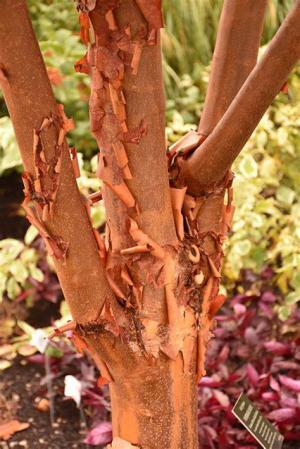Paperbark maple offers stunning fall foliage
Before paper, there was papyrus. Indeed, our word “paper” is taken from the ancient Egyptian word for papyrus, papuro. The Chinese invented paper about 2,000 years ago, and it has been with us ever since.
The Japanese invented the art of paper folding, called origami, in the 17th century. So, it is fitting that there is a tree used for bonsai in Japan whose bark peels off like sheets of paper, the paperbark maple (Acer griseum).
This tree has smooth, shiny, reddish-orange bark that, as it matures, peels off in thin, shaggy layers. The effect in the garden is stunning, especially in winter when so much else is drab and gray.
Maple leaves famously change color in the autumn, and the paperbark maple is stunning with fall foliage in red, orange and even shades of pink.
In early spring, the tree blooms with tiny, light-green flowers that are hard to spot, unless you are a bee. Like all maple trees, paperbark maple is an important source of pollen for honey bees in early spring, when few other flowers are in bloom.
Following the blooms are the seedpods, called samaras. These are the typical maple tree “helicopters“ that form in pairs with flat wings that let them spin while falling and travel quite a ways carried by the winds. Luckily, most of the seeds are sterile, so you won't have to constantly pull unwanted seedlings from around the garden.
These are slow-growing trees that eventually only get 25 feet tall, with branches spread 15 to 20 feet wide. They are perfect for smaller yards or planted in front of larger trees.
You may want to plant this beautiful tree near your house so you can enjoy it year-round. It also works well as an understory tree in woodsy settings. Plant perennials around the trunk such as hostas and periwinkle (Vinca minor).
Paperbark maple is quite adaptable as to soil and is one of the few trees that grows well in heavy clay soil. These trees also thrive in full sun or partial shade.
Once they are well established, paperbark maples are quite tolerant of drought. They are also typically free of diseases and rarely attacked by insect pests.
You can propagate paperbark maples from seeds or cuttings, or by grafting onto the rootstock of sugar maples (Acer saccharum).
Because paperbark maple seeds have very low germination, cuttings are the easiest way to increase your supply of these colorful trees.
Even during summer, this tree offers color because the leaves are dark green on top contrasting against their silvery undersides.
Plant paperbark maple , and you will have a well-behaved, slow-growing tree that feeds the bees in early spring, has two-toned leaves all summer, bursts into fiery red, orange and pink foliage in the fall, and best of all, has colorful peeling bark all winter.
As for folding paper into origami? Paper is amazing – you cannot fold a piece of paper in half more than six times before it is too strong to fold.




















































